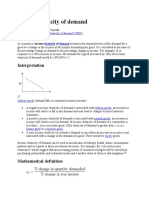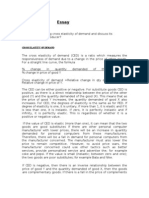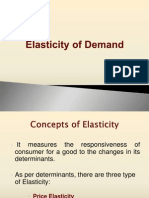Critiques Are Posted On 2/21 You or Your Team Is Permitted To Comment If You Wish
Critiques Are Posted On 2/21 You or Your Team Is Permitted To Comment If You Wish
Uploaded by
billCopyright:
Available Formats
Critiques Are Posted On 2/21 You or Your Team Is Permitted To Comment If You Wish
Critiques Are Posted On 2/21 You or Your Team Is Permitted To Comment If You Wish
Uploaded by
billOriginal Description:
Original Title
Copyright
Available Formats
Share this document
Did you find this document useful?
Is this content inappropriate?
Copyright:
Available Formats
Critiques Are Posted On 2/21 You or Your Team Is Permitted To Comment If You Wish
Critiques Are Posted On 2/21 You or Your Team Is Permitted To Comment If You Wish
Uploaded by
billCopyright:
Available Formats
Homework 03
ANSW
ECON 305.
Dr. Dan Gerlowski
This homework assignment is to be understood by all students. It will be presented
by the Charcoal and Red teams by Saturday 2/19/11 at 11:00 p.m. Each of these
teams will submit one word file to the conferences section of the course not to
the conferences for the individual study groups but to the course conference
section. In the main course conference section they will respond to my conference
posting for homework number 3. The Green and Salmon teams are to provide
comment and critique. The Green Team will comment and critique the Charcoal
Teams work; the Salmon Team will comment and critique the Red Teams work.
These comments and critiques are due by Monday 2/21/11 at 11:00 p.m. For
further details please check the link off of the course syllabus. The comment and
critique will represent the commenting teams single response; if you present
different points of view discuss them fully. After the two sets of comments and
critiques are posted on 2/21 you or your team is permitted to comment if
you wish.
1. In the market for Good X
shown at right, a price floor
is imposed at a price of PF =
$7.23 Please answer the
following questions about
this market.
a. How many units of the
good are exchanged at
the mandated price?
b. Tell whether there is
excess demand or excess supply and how many units are
involved.
c. Describe at least one type of non-market transaction that
may occur to move the market towards equilibrium.
a. With the mandated price there will be 205 units
exchanged. Sure 285 will be brought to market, but only
205 will be purchased
b. There is an excess supply of 80 units.
c. Sellers may begin to cut price in ways that dont
address the law; i.e. with a buy 2 get 1 free type thing, or
engaging in secret sales perhaps on a black market.
2. The demand function for good G is given by QDG = 150 +
0.005*M 2*PG. The supply function for good G is given by QSG
= 1.3333 +60*PG .
a. If consumer income is 100,000 what is the demand
function for good G?
The demand function becomes by QDG = 650 2*PG
b. Again if consumer income is 100,000 what is the market
equilibrium price and quantity?
The demand function becomes by QDG = 650 2*PG and
you can solve for equilibrium to be price = 10.46,
quantity equal 629 (subject to rounding)
c. If consumer incomes increase to 120,000 what is the new
market equilibrium?
The demand function becomes by QDG = 750 2*PG and
you can solve for equilibrium to be price = 12.08 and
quantity equal 726 (subject to rounding)
3. For each of the following pairs of goods please identify which you
expect to have a more elastic demand in terms of the goods own
price. Use one of the 3 factors impacting price elasticity of demand
given in the text.
a. Ford Focus versus All automobiles.
For Focus will have a more elastic demand because there are
more substitutes for a Ford Focus than there are for all
automobiles.
b. Coke versus soft drinks.
Coke will have a more elastic demand because there are more
substitutes for Coke than there are for all soft drinks.
c. Table salt versus Lettuce.
Lettuce will have a more elastic demand because lettuce is a
bigger percentage of the consumers budget than table salt.
d. Heart medications (a group) versus Nike sports shoes.
Nike Sports Shoes because there are there are substitutes
available.
e. Cocaine to an addict versus Android cell phones.
Android cell phones because there are substitutes for them,
while there is no substitute for cocaine for an addict.
4. Suppose that he demand function for good X is given by Q DX = 100
3*PX + 0.002*ADVX where QDX is the quantity demanded of good X, PX
is the price of good X, and ADVX is the amount of advertising done
for good X. Fully explain each calculation that you do.
a. If the amount of advertising is fixed as $150,000 what is the
own price elasticity of demand when the price of good X equals
50?
Substituting 150,000 in for advertising gives us a demand
function of 400 3*PX When the Price of X equals 50 the
quantity demanded is 250. Using the equation on p. 91 we get
(-3)*(50/250) = -0.6
b. If the amount of advertising is fixed as $150,000 what is the
own price elasticity of demand when the price of good X equals
60?
Using the demand above with the constant term of 400, the
quantity demanded is now 220. Using the equation on p. 91
we get (-3)*(180/220) = -0.818
c. If the amount of advertising for good X increases and the
increased advertising works to make people more strongly
desire good X, how would we expect the price elasticity of
demand to change because of the increased advertising?
If the advertising works to make good X more attractive, we
would think then that the increased advertising would make
good X more attractive relative to any competing products or
uses of consumer funds; put another way we would expect the
advertising to convince consumers that there are fewer
substitutes for good X and we would expect to see demand
become less elastic or more inelastic i.e. we would expect to
see the elasticity number get smaller in absolute value.
d. If the amount of advertising increases to $175,000 what is the
own price elasticity of demand for good X when the price of X
equals 60?
We need to resolve the demand function using 175,000. We
get of 450 3*PX Again using the formula on p. 91 we get (3)*(60/270) =- 0.666.
e. Did your calculation in part d meet your expectations from part
c?
Yes, we expected to see demand get less elastic or more
inelastic and it did going from -0.8 in part b. to -0.6 in part d.
5. The demand curve for a product is given by QDX = 1000 2*PX +
0.02*PZ, where PZ = $400.
a. What is the own price elasticity of demand when PX = 154?
Subbing in we get 1008 2*PX which equals 700.
is then (-2)*(154/700) = -0.44
The formula
b. Is demand elastic or inelastic at this price?
Since it is less than 1 in absolute value, demand is inelastic.
c. What would happen to the firms total revenue if it decided to
charge a price below 154?
If a price less than $154 is charged then total revenues would
decline. An increase in price would raise total revenues.
d. What is the cross price elasticity of demand between good X
and good Z when PX = 154? Are goods X and Z substitutes of
compliments?
Cross price elasticity using the equation on p. 91 we get
(0.02)*(154/700) 0.0044. Since it is positive, the goods are
substitutes.
6. Suppose the cross price elasticity of demand between goods X and Y
is -5.0. How much would the price of good Y have to change in order
to increase the consumption of good X by 50%?
Using the equation from the book, or the concept around the
equation on page 86, I get a reduction in the price of good Y of 10%
is needed.
7. I observe that the market for Fisbins had an equilibrium price of
$100 and an equilibrium quantity of Fisbins exchanged of 2100 in
2001. I also observe that in June, 2010 the equilibrium price of
Fisbins was $200 and the quantity of Fisbins exchanged was 4200.
Can I conclude from these observations that the demand for Fisbins
is perfectly inelastic? Fully explain why or why not.
No, the ceterius paribus assumption is violated because many years
have passed. The elasticity of demand is drawn for a given demand
curve if the demand curve shifts then there is a new elasticity of
demand..
8. Suppose the inverse demand function for good X is given by PX =
100 -0.05*QX. If the quantity demanded of good X is 1800, what is the price
elasticity of demand for good X.
There are many ways to do this problem. Per the formula in the
text we need to use the demand function not the inverse demand
function to find the coefficient of price. If we rearrange the inverse
demand function to get the demand function we get Q = 2000
20*PX. Then we apply the formula (-20)*(10/1800) = -0.1111
You might also like
- Solution Manual For Microeconomics 5th Edition by David BesankoDocument26 pagesSolution Manual For Microeconomics 5th Edition by David BesankomohsinwazirNo ratings yet
- Principles of MicroeconomicsDocument16 pagesPrinciples of MicroeconomicsAnonymous GAulxiI100% (4)
- Economics for CFA 2024: level 1 in just one week: CFA level 1, #4From EverandEconomics for CFA 2024: level 1 in just one week: CFA level 1, #4Rating: 4.5 out of 5 stars4.5/5 (2)
- Consumer's Behavior - Essay Questions With AnswersDocument5 pagesConsumer's Behavior - Essay Questions With AnswersPetru Verdeș100% (2)
- Problem Set 3 - SolutionDocument10 pagesProblem Set 3 - SolutionlaraNo ratings yet
- A level Economics Revision: Cheeky Revision ShortcutsFrom EverandA level Economics Revision: Cheeky Revision ShortcutsRating: 3 out of 5 stars3/5 (1)
- Problem Sessions Before Midterm ExamDocument15 pagesProblem Sessions Before Midterm Exammusadhiq_yavar100% (1)
- As1 &2Document29 pagesAs1 &2Emiru ayalewNo ratings yet
- BECO575-Extra Problems 1 (CH 2 - Demand, Supply, and Equilibrium Prices CH 3 - Demand Elasticities)Document9 pagesBECO575-Extra Problems 1 (CH 2 - Demand, Supply, and Equilibrium Prices CH 3 - Demand Elasticities)Jamal EzziNo ratings yet
- Chapter 5: (Elasticity and Its Application) Section ADocument7 pagesChapter 5: (Elasticity and Its Application) Section APhạm Huy100% (1)
- Assignment - 2 With Answer-1Document7 pagesAssignment - 2 With Answer-1rawan ANo ratings yet
- Block 3Document3 pagesBlock 3Laura Sofia Vasquez GarciaNo ratings yet
- Exercise Questions (Chs 4-5)Document12 pagesExercise Questions (Chs 4-5)1234assNo ratings yet
- InstructionsDocument15 pagesInstructionsMarivicEchavezBulaoNo ratings yet
- Econ11 Exer2 ChangeSectionNo ChangeYourSurnameDocument3 pagesEcon11 Exer2 ChangeSectionNo ChangeYourSurnameJomel De GuzmanNo ratings yet
- Income Elasticity of Demand: InterpretationDocument10 pagesIncome Elasticity of Demand: Interpretationabhijeet9981No ratings yet
- Demand and Supply (Preparation)Document6 pagesDemand and Supply (Preparation)Шугыла ЕсимханNo ratings yet
- EconomicDocument6 pagesEconomicDaniloCardenasNo ratings yet
- Latihan Soal Pengantar EkonomiDocument3 pagesLatihan Soal Pengantar Ekonomihilmisifa100% (1)
- Topic 6 Elasticity and Its Application QuestionDocument8 pagesTopic 6 Elasticity and Its Application QuestionMIN ENNo ratings yet
- The Law of DemandDocument5 pagesThe Law of Demandcalebantwi657No ratings yet
- ElasticityDocument2 pagesElasticityDati PapinashviliNo ratings yet
- Samples For Quiz 2Document7 pagesSamples For Quiz 2nafsanrashid360No ratings yet
- SolutionsDocument5 pagesSolutionsankush birla50% (2)
- Individual & Market DemandDocument12 pagesIndividual & Market DemandAkshay ModakNo ratings yet
- ECON 373 HuqDocument6 pagesECON 373 HuqMarva Nic BranNo ratings yet
- CBSE Sample Paper For Class 12 Economics With SolutionsDocument11 pagesCBSE Sample Paper For Class 12 Economics With SolutionsAritroy KunduNo ratings yet
- Soal Tugas #2Document2 pagesSoal Tugas #2jambumbekNo ratings yet
- MIcro Tutorial 5 ANSDocument5 pagesMIcro Tutorial 5 ANSBintang David SusantoNo ratings yet
- ECON 203 SolutionsDocument6 pagesECON 203 SolutionsRevshin Mae FelizariaNo ratings yet
- Half-Yearly Examination Paper 2014 Class Xii Subject: EconomicsDocument10 pagesHalf-Yearly Examination Paper 2014 Class Xii Subject: EconomicsNisha JainNo ratings yet
- Individual and Market Demand: Questions For ReviewDocument21 pagesIndividual and Market Demand: Questions For ReviewHimesh AnandNo ratings yet
- 3cDky0gaSXu2otutorial 1Document5 pages3cDky0gaSXu2otutorial 1Bee HuiNo ratings yet
- 2) in December, The Price of Christmas Trees Rises and The Quantity of Trees Sold Rises. Is This A Violation of The Law of Demand?Document2 pages2) in December, The Price of Christmas Trees Rises and The Quantity of Trees Sold Rises. Is This A Violation of The Law of Demand?Muhammad ZahidNo ratings yet
- WKSHTDocument8 pagesWKSHTjohnNo ratings yet
- EconomicsDocument18 pagesEconomicsMalik WajihaNo ratings yet
- Practice Questions (Set 2)Document3 pagesPractice Questions (Set 2)biaquinovicenteNo ratings yet
- BB 107 (Spring) Tutorial 5(s)Document4 pagesBB 107 (Spring) Tutorial 5(s)高雯蕙No ratings yet
- ElasticityDocument14 pagesElasticitysidlbsimNo ratings yet
- Assignment 2 Demand & Supply PDFDocument6 pagesAssignment 2 Demand & Supply PDFhemantNo ratings yet
- Intro To Macro Midterm Answer KeyDocument10 pagesIntro To Macro Midterm Answer KeyAigerim SerikkazinovaNo ratings yet
- Problem SetDocument61 pagesProblem SetEmily FungNo ratings yet
- Assignment 2 (B) Managerial EconomicsDocument8 pagesAssignment 2 (B) Managerial EconomicsHammad Aqdas100% (1)
- BB 107 Tutorial 5Document4 pagesBB 107 Tutorial 5Frederick Goldwin SoegihartoNo ratings yet
- Set 6 AnswersDocument11 pagesSet 6 AnswersidentifierNo ratings yet
- Ignou Sovled Assignment Ms09Document20 pagesIgnou Sovled Assignment Ms09Jugal Maharjan0% (1)
- Econ HWDocument3 pagesEcon HWmiggawee880% (1)
- (Intro Micro) Bank Soal UTS - TutorkuDocument24 pages(Intro Micro) Bank Soal UTS - Tutorkuantonius.rafael10No ratings yet
- 2-Handout Two-Elasticity-Chapter FourDocument10 pages2-Handout Two-Elasticity-Chapter FourImran UmarNo ratings yet
- Ae LM 2ND Quarter FinalDocument6 pagesAe LM 2ND Quarter FinalRhystle Ann BalcitaNo ratings yet
- Lesson 2 - Demand and Supply Analysis Practice QuestionsDocument25 pagesLesson 2 - Demand and Supply Analysis Practice QuestionsMukhrizIzrafAzmanAzizNo ratings yet
- Elasticity QuestionsDocument9 pagesElasticity QuestionsMercy MbiseNo ratings yet
- MIT11 203F10 ExamprepsolDocument9 pagesMIT11 203F10 Examprepsol19. Vũ Anh KhoaNo ratings yet
- Practice MidtermDocument4 pagesPractice MidtermLinda GeNo ratings yet
- Cross Price ElasticityDocument6 pagesCross Price ElasticityRavi KumudeshNo ratings yet
- Group Assignment No 2 For The Course Introduction To EconomicsDocument6 pagesGroup Assignment No 2 For The Course Introduction To Economicsloarifse16No ratings yet
- Practice Exercise Ch.6 BECN 150 (ST) F-21)Document11 pagesPractice Exercise Ch.6 BECN 150 (ST) F-21)brinthaNo ratings yet
- Ungraded Exercises Chapter 4-6Document20 pagesUngraded Exercises Chapter 4-6lana del reyNo ratings yet
- Quantitative Demand Analysis: Conceptual and Computational QuestionsDocument2 pagesQuantitative Demand Analysis: Conceptual and Computational QuestionsHào BùiNo ratings yet
- Samples Chapter 6 ElasticityDocument12 pagesSamples Chapter 6 Elasticitynafsanrashid360No ratings yet
- Homework2 f11 Econ110 AnswersDocument9 pagesHomework2 f11 Econ110 AnswersJames GiangrandeNo ratings yet
- Macroeconomics For Today 9th Edition Tucker Test Bank 1Document73 pagesMacroeconomics For Today 9th Edition Tucker Test Bank 1rosemary100% (64)
- PS5 ECO101 PS5 Elasticity Part2 SolutionsDocument6 pagesPS5 ECO101 PS5 Elasticity Part2 SolutionsAlamin Ismail 2222905630No ratings yet
- Calculating The Price Elasticity of DemandDocument13 pagesCalculating The Price Elasticity of DemandRoubonNo ratings yet
- Microeconomics I (4) - 1Document101 pagesMicroeconomics I (4) - 1chala6667No ratings yet
- Applied Economics: Quarter 3 - Module 4: Market PricingDocument28 pagesApplied Economics: Quarter 3 - Module 4: Market PricingJtm GarciaNo ratings yet
- Lesson 4 - Consumption and Savings PDFDocument15 pagesLesson 4 - Consumption and Savings PDFJoshua CabinasNo ratings yet
- CH5 Scheduled Quiz - Question PoolDocument4 pagesCH5 Scheduled Quiz - Question PoolThomas LawrenceNo ratings yet
- Research ProjectDocument28 pagesResearch ProjectNayomi Ekanayake100% (1)
- Arc ElasticityDocument2 pagesArc ElasticitySujatha MohanNo ratings yet
- FURRERA فوريرةDocument5 pagesFURRERA فوريرةsamNo ratings yet
- Chap 3: The Theory of Consumer ChoiceDocument3 pagesChap 3: The Theory of Consumer ChoiceHuệ Nhi PhanNo ratings yet
- Varian - Chapter06 - Demand - Properties of Demand FunctionsDocument14 pagesVarian - Chapter06 - Demand - Properties of Demand FunctionsBella NovitasariNo ratings yet
- Two Period ModelDocument23 pagesTwo Period ModelrathikkNo ratings yet
- The Cross Elasticity of DemandDocument3 pagesThe Cross Elasticity of DemandShahid SagheerNo ratings yet
- Eco ProjectDocument22 pagesEco ProjectShashiRaiNo ratings yet
- Possibilities, Preferences, and ChoicesDocument45 pagesPossibilities, Preferences, and Choicesammar donNo ratings yet
- Supply and Demand FrameworkDocument3 pagesSupply and Demand FrameworkJuan Pablo ArrivillagaNo ratings yet
- K. J. Somaiya Juniour College of Arts and Commerce: S.Y.J.CDocument10 pagesK. J. Somaiya Juniour College of Arts and Commerce: S.Y.J.CSWAPNIL JADHAVNo ratings yet
- Utility AnalysisDocument32 pagesUtility AnalysisJyotiNo ratings yet
- A Study of Consumer Buying Behaviour Towards Maruti SuzukiDocument63 pagesA Study of Consumer Buying Behaviour Towards Maruti Suzukiashishsingh.hb181No ratings yet
- PErloff Chapter 3Document28 pagesPErloff Chapter 3SelcenZ100% (1)
- Demand & SupplyDocument11 pagesDemand & SupplyHaniNo ratings yet
- Tourism PromotionDocument8 pagesTourism PromotionAnnaliza B. Sagat-SantosNo ratings yet
- Theory of Marginal Utility AnalysisDocument4 pagesTheory of Marginal Utility AnalysisBalasingam Prahalathan100% (3)
- 4 ElasticityDocument54 pages4 Elasticitysneha.tyagi1003No ratings yet
- EC203 - Midterm - SolutionsDocument7 pagesEC203 - Midterm - SolutionsYiğit KocamanNo ratings yet
- Elasticity of DemandDocument88 pagesElasticity of DemandAkshay ThaparNo ratings yet
- Exhibitors BEAUTYISTANBUL2022Document7 pagesExhibitors BEAUTYISTANBUL2022ibadNo ratings yet
- Chapter 4 Theory of Consumer BehaviourDocument9 pagesChapter 4 Theory of Consumer BehaviourYus Linda100% (1)

























































































